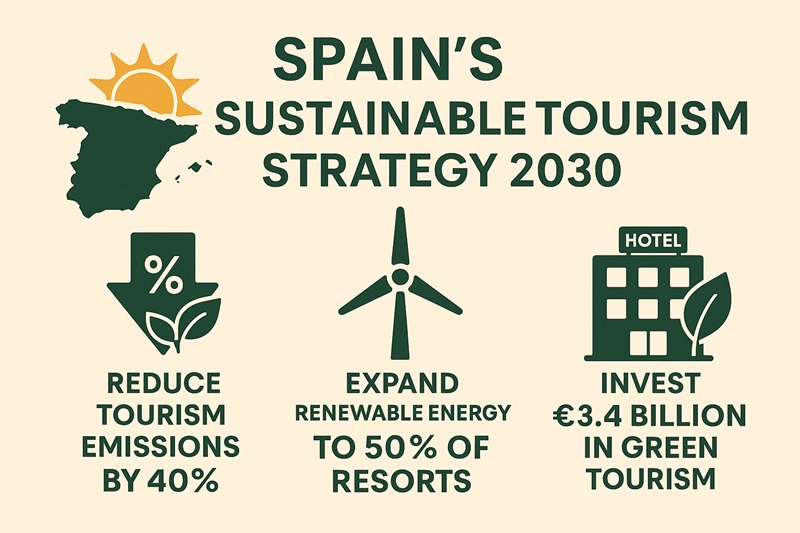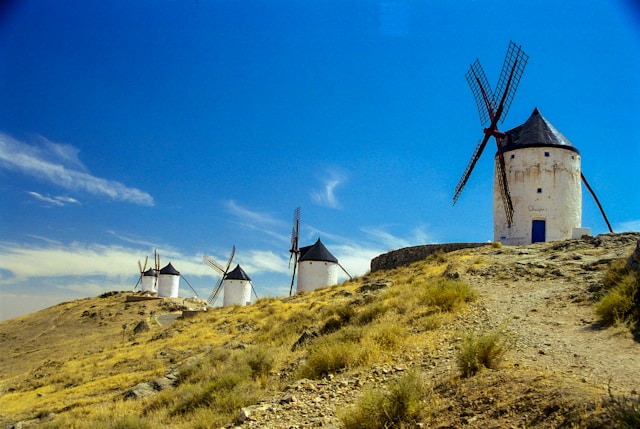Spain is now a global example of green living and smart travel. Through its Sustainable Tourism Strategy 2030, the country plans to cut travel pollution by 40%, use more clean energy, and protect nature.
Cities like Barcelona and Valencia show this change every day. They have car-free streets, solar parks, and smart-city systems that make life cleaner and easier. Eco-hotels such as Abora Buenaventura and the Paradores use local materials and save energy while keeping their comfort and style.
Spain also promotes green buildings, renewable energy, and local food. Many people here live with the planet in mind—showing that comfort, culture, and care for nature can work together.
Spain’s Green Revolution
Spain’s green shift is not just a short trend—it’s a big national plan. The Sustainable Tourism Strategy 2030 helps move the country toward clean energy, less waste, and eco-friendly travel. With more than €3.4 billion in EU funds, the program supports both cities and small towns.
In Barcelona, the city’s Superblocks reduce traffic and cut carbon pollution by about 30%. In the Balearic Islands, new rules make hotels recycle most of their waste and ban single-use plastics. This makes the islands one of Europe’s first examples of a circular economy in tourism.
Across Spain, eco-resorts and Paradores use solar panels, save water, and design with local materials. Cities like Seville and Valencia are also adding more solar power. The slow-food movement promotes regional foods and traditional dishes that are better for the environment.
Together, these ideas make Spain cleaner and more enjoyable for people who live or travel there.
Spain’s Green Vision
Spain’s way of going green is both practical and passionate. The government, local groups, and private companies all work together to make sustainable travel easy and popular. It’s part of what makes Spain’s identity unique.
In 2023, Spain ranked among Europe’s top ten sustainable destinations, praised for its green energy, smart transport, and respect for culture. From solar hotels to electric buses, Spain shows that travel can help nature instead of harm it.
This proves a simple truth: sustainability doesn’t limit travel—it makes it smarter, cleaner, and better for the future.

Spain’s National Push Toward Sustainable Tourism
The Sustainable Tourism Strategy 2030
Spain’s plan for green travel follows the EU Green Deal and the UN Sustainable Development Goals (SDGs).
Its main goals are simple and clear:
- Cut travel-related carbon emissions by 40%.
- Shift half of all resorts to renewable energy.
- Use circular economy ideas to reduce waste and pollution.
These steps help everyone in tourism—from airlines to small inns—follow real, trackable rules for sustainability.
Government and Funding Support
Spain is putting strong support behind this plan. With help from the Next Generation EU fund, the country has invested €3.4 billion in green tourism projects.
This money helps cities build:
- Green public spaces for locals and visitors.
- Eco-mobility systems like electric buses and bike paths.
- Smart digital tools that balance tourism and nature.
Some great examples include:
- Malaga and Bilbao testing smart sensors to monitor how many people visit heritage sites.
- Valencia’s Green Capital project, which uses renewable energy data to guide city planning.
Together, these actions make Spain a cleaner, smarter, and more balanced place for travelers and residents alike.
You may like to read : Why Locals in Spain Are Fed Up
Eco-Resorts and Smart Infrastructure for Conscious Travelers
Spain’s hotels and resorts are going green fast. From luxury stays to small country inns, caring for the planet is now the rule, not the exception.
Green Resort Innovations
Modern eco-resorts now use:
- Renewable energy like solar, wind, and geothermal power.
- Water-saving systems for pools and gardens.
- Eco materials such as bamboo, recycled glass, and local stone.
Examples in Action:
- Abora Buenaventura by Lopesan Hotels, a hotel that has energy-efficient systems and waste-reducing measures, all whilst maintaining a high standard of service for guests. Staying in these eco-resorts allows you to be able to enjoy a guilt-free holiday where sustainability remains at the heart.
- Parador de Cádiz (Andalusia) – uses seawater and geothermal cooling to save fresh water.
- Mas Salagros EcoResort (Barcelona region) – Spain’s first 100% eco-sustainable resort powered by solar and geothermal energy.
- Royal Hideaway Corales Suites (Tenerife) – built with smart design, rainwater recovery, and awarded the Travelife Gold Certification.
These hotels follow trusted eco-labels like EU Ecolabel, Biosphere Responsible Tourism, and Travelife, making their green work open and easy to check.
The Role of Paradores
Spain’s historic Paradores—more than 90 state-run hotels set in castles, monasteries, and palaces—combine history with sustainability.
Their green steps include:
- Cutting water use by 20%.
- Expanding solar power
- Using local, organic food to support nearby farms.
These efforts protect heritage buildings while creating eco-friendly stays for travelers who care about both culture and the planet.
Community-Level Innovation and Local Initiatives
National plans create structure, but real progress happens in local communities.
Barcelona’s Superblocks
In Barcelona, Superblocks limit car traffic, cut air pollution, and encourage walking and cycling. These green zones also bring nature back to the city—adding trees, gardens, and wildlife to once-busy streets.
Balearic Islands: A Circular Economy Model
The Balearic Islands have made bold rules for clean tourism. Their law bans single-use plastics, requires hotels to use renewable energy, and makes them publish yearly reports on sustainability. This keeps both tourists and businesses accountable.
Rural Green Destinations
Regions like Asturias, Navarra, and La Rioja stand out for their eco-villages, organic farms, and eco-certified lodgings. Travelers there enjoy real cultural experiences while helping protect local nature and traditions.

How Spain Promotes Eco-Living Beyond Tourism
Spain’s green actions reach beyond hotels and beaches—they shape cities, homes, and everyday habits.
Renewable Energy and Smart Cities
- Over 45% of Spain’s electricity now comes from renewable sources (IEA, 2024).
- Seville and Madrid lead with electric buses and solar-powered public buildings.
- Valencia, a European Green Capital, turns waste into energy and builds shaded cooling corridors.
Sustainable Architecture
Modern buildings like Madrid’s Edificio Endesa and Seville’s Metropol Parasol show how design can save energy. Their smart structures cut cooling needs by up to 60%, says the Spanish Institute for Energy Diversification (IDAE).
Slow Food and Circular Economy
Spain’s food culture supports sustainability too. The slow-food movement promotes small farms, seasonal menus, and local produce. Markets such as Mercado de San Miguel in Madrid and La Boqueria in Barcelona now lead zero-waste projects.
How to Experience Eco-Friendly Spain as a Traveler
Visitors can travel green and enjoy Spain’s eco-lifestyle at the same time:
- Stay certified: Pick hotels with EU Ecolabel, Biosphere, or Travelife
- Travel smart: Use RENFE’s high-speed trains (AVE) or rent electric bikes in cities.
- Support local: Eat at farm-to-table restaurants, join eco-volunteering, or explore Spain’s Green Routes for hiking and cycling.
Small choices like these help protect the planet and create richer travel experiences.
The Future of Spain’s Sustainable Travel and Living
Spain is preparing for a greener future. It plans to:
- Use AI tools to manage tourist flow and protect nature.
- Build carbon-neutral airports and solar-powered EV chargers.
- Create green corridors connecting cities and national parks.
By 2050, Spain aims to be one of the world’s first climate-neutral tourism countries, setting a strong example for others.
Why Spain’s Eco-Living Model Matters Globally
Spain’s progress works because people, policy, and innovation come together. It shows that economic growth and environmental care can go hand in hand.
By blending old traditions with new technology, Spain proves that sustainability isn’t a limit—it’s an upgrade.
Here, green living is more than a trend—it’s a way of life the whole world can learn from.



